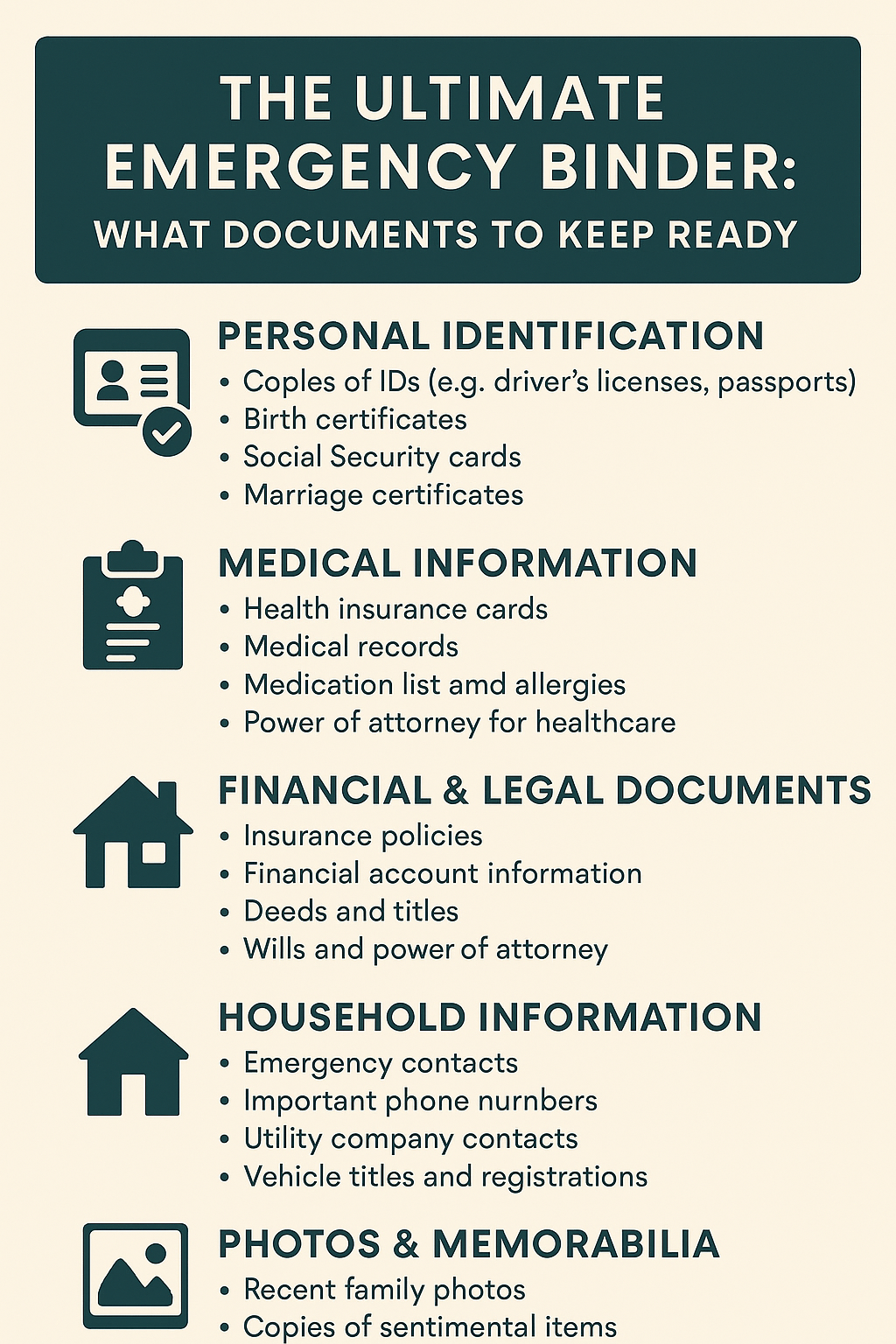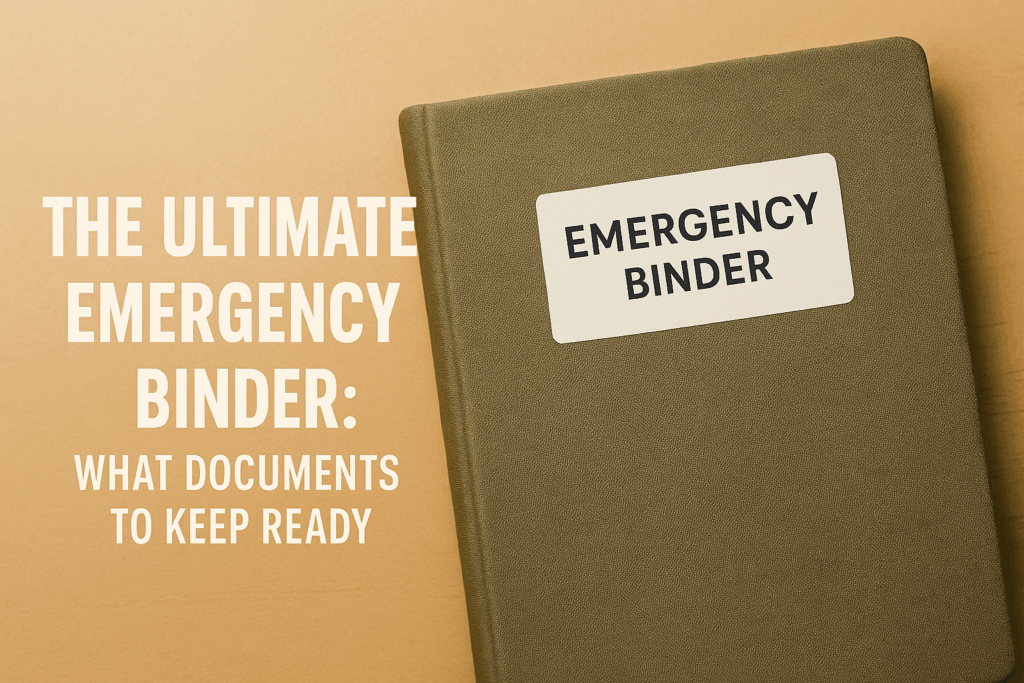I always thought I’d be the last person to build an emergency binder. It felt like something paranoid people did—until I watched a neighbor scramble for insurance papers during a flood evacuation. That moment changed everything. Emergencies don’t ask for your schedule. They just show up. And when they do, having all your essential documents in one place can mean the difference between chaos and control. That’s when I started building my emergency binder checklist, and now it’s one of the most comforting things I own. It’s like a seatbelt for your life—useless until it’s suddenly everything.
Step 1: Start with Personal Identification
First things first—your emergency binder checklist should begin with documents that prove who you are. Sounds obvious, but in the middle of a disaster, you’d be shocked how often these go missing. Include copies of driver’s licenses, passports, birth certificates, Social Security cards, and any immigration or residency papers. For kids, add school IDs and vaccination records. I made digital copies too (saved to an encrypted flash drive), just in case. Keeping these together means no scrambling at border crossings, hospitals, or shelters. It’s a small step that brings massive peace of mind.
Step 2: Gather Medical Information and Health Records
Next, I tackled the section I never wanted to think about: medical info. But if you or a loved one ends up unconscious or stranded without medication lists, it can get dangerous fast. Your emergency binder checklist should include health insurance cards, allergy lists, prescriptions, chronic condition summaries, and emergency contacts for doctors. If someone in your home has a disability, include care instructions or legal documents like medical power of attorney. I also added a printed list of my mom’s meds and conditions, just in case I’m not there. It’s not over-prepping. It’s love in paper form.
Step 3: Add Financial and Legal Essentials
Imagine needing to access funds, prove ownership, or settle a legal matter during a crisis—and not having the paperwork. That’s why your emergency binder checklist needs financial and legal backups. I included copies of bank account details, credit cards (front and back), insurance policies, loan agreements, deeds, leases, wills, and power of attorney documents. Don’t forget digital asset info too—passwords, crypto keys, and online subscriptions. Use a password-protected USB for sensitive stuff, and keep one printed sheet with high-level contacts and account numbers in the binder. It feels intense, but these few pages could save weeks of trouble.
Step 4: Secure Household Information and Emergency Contacts
When we left town for a medical emergency last year, I realized I didn’t even know my plumber’s number—or which company handled our solar panels. Your binder should include a list of emergency contacts beyond just friends and family: landlord, utility providers, repair services, neighbors, even your pet sitter. Add copies of utility bills, vehicle titles, home warranties, and appliance manuals too. Bonus points for keeping evacuation routes, shelter addresses, and a copy of your family’s emergency plan in this section. The emergency binder checklist becomes your lifeline when cell service is down and memory fails.
Step 5: Include Family Photos and Personal Memorabilia
This might sound sentimental—but I added a few printed family photos to my binder, and I’m so glad I did. In an evacuation, if you’re separated or have to prove a child is yours, photos are essential. I also tucked in copies of irreplaceable keepsakes—like letters, drawings, and certificates. It’s not about hoarding memories—it’s about grounding yourself when everything feels uprooted. Your emergency binder checklist should reflect what matters to you. For me, this section reminded me that survival isn’t just physical—it’s emotional too. Sometimes, a little normalcy is the best prep of all.
Step 6: Protect, Update, and Store It Right
Once everything was gathered, I used waterproof sleeves and a fireproof binder (like this one: Amazon Fireproof Binder) to keep it safe. I also made two backup copies—one digital, encrypted and stored offsite, and one paper copy in my emergency go-bag. I’ve set a reminder to review and update the binder every six months, especially after big life changes (like moving or changing insurance). The emergency binder checklist isn’t a one-and-done thing. It’s a living document that grows with you—and protects you when life spins out of control.

Final Thoughts: One Binder, So Much Peace
Honestly, building an emergency binder felt overwhelming at first. But now that it’s done, I can’t tell you the relief it brings. Emergencies don’t wait for you to get your act together. With one small binder, I know that if the worst happens, I’ve already handled a big part of the chaos. And that gives me space to focus on protecting the people I love. My hope? That you’ll start your emergency binder checklist this week. Because you don’t need to be perfect—you just need to be prepared.
References:
FEMA Emergency Financial First Aid Kit (EFFAK)
https://www.fema.gov/pdf/library/effak.pdf
(This is FEMA’s official guide to collecting critical financial documents.)
Ready.gov – Financial Preparedness
https://www.ready.gov/financial-preparedness
(Government resource on organizing financial records for disasters.)
Red Cross – Make a Plan
https://www.redcross.org/get-help/how-to-prepare-for-emergencies/make-a-plan.html
(Advice on emergency planning including document organization.)
Consumer Financial Protection Bureau – Get your financial house in order
https://www.consumerfinance.gov/consumer-tools/disaster-financial-preparation/
(Help with financial and legal document prep for emergencies.)
A Bowl Full of Lemons – Emergency Binder Setup
https://www.abowlfulloflemons.net/2016/10/emergency-binder.html
(DIY binder inspiration and printables from a prep-focused lifestyle blog.)
Thirty Handmade Days – Free Emergency Binder Printables
https://www.thirtyhandmadedays.com/emergency-binder-printables-updated/
(Popular downloadable templates to start your own binder.)
Mom with a Prep – Emergency Binder Ideas
https://momwithaprep.com/emergency-binder/
(Detailed breakdown of binder sections and what to include.)
Nolo – What Is a Power of Attorney?
https://www.nolo.com/legal-encyclopedia/free-books/elder-law-book/chapter7-2.html
(Good legal reference to understand POA and related documents.)




